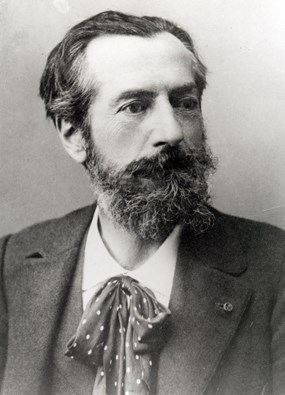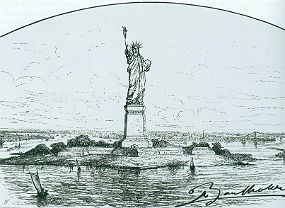
National Park Service, Statue of Liberty NM The sculptor behind the Statue of Liberty, Frédéric Auguste Bartholdi, was born in 1834 in Colmar, France in the Alsace region on the border of Germany. When Auguste was nine, his mother Charlotte moved with her children to Paris to enroll them at the Lycée Louis-le-Grand and allow them to study under some of France’s most accomplished artists, braving the city’s civil unrest for her sons’ education. After completing his first commissioned work at age twenty, a large bronze statue of Napoleonic General Jean Rapp, Bartholdi travelled with a group of French cultural ambassadors to photograph works of antiquity in Egypt. They encountered desert landscapes where ancient cities lay in ruins but colossal statues remained, inspiring Bartholdi to write “These granite beings, in their imperturbable majesty, seem to be still listening to the most remote antiquity. Their kindly and impassible glance seems to ignore the present and to be fixed upon an unlimited future.” As an emerging artist, Bartholdi actively searched for commissions as well as inspiration, and he secured a meeting with Khedive Isma'il Pasha of Egypt, the ruler overseeing and funding the French construction of the Suez Canal. Bartholdi presented a figurine for a colossal lighthouse depicting an Egyptian fellah, a female serf, entitled Egypt (or Progress) Carrying the Light to Asia. This design was ultimately rejected by the khedive. 
National Park Service, Statue of Liberty National Monument Bartholdi’s relationship with the scholar Édouard de Laboulaye would provide him with another opportunity to achieve the colossal. Laboulaye was an abolitionist and professor of American democracy who presented an idea that Bartholdi would use to shape and promote his work: a gift of friendship between two countries with democratic ideals, America and France. However, artistic ambitions were set aside as Napoleon III enlisted France into a war against Prussia and Germany. Bartholdi led a local regiment of soldiers to defend his hometown, but like France itself, he would ultimately surrender. Germany annexed Colmar, and Paris was again thrown into political upheaval. With few places to turn, Bartholdi boarded a ship to America to seek support and a suitable location for his new colossal project. 
National Park Service, Statue of Liberty National Monument Armed with letters of introduction from Laboulaye, Bartholdi secured meetings with some of America’s most influential people, with mixed results. In a little under three months, Bartholdi found a preferred location for the statue on Bedloe’s Island in New York Harbor, a new commission for a frieze at the Brattle Square Church in Boston, and the possibility of displaying some works at the upcoming Centennial Exposition in Philadelphia. However, he received little more than words of encouragement regarding the construction of a colossal statue. Over the next few years Bartholdi and Laboulaye set up committees in the two countries. France would raise funds for the statue while Americans raised money for the pedestal. Bartholdi involved himself and his work in the fundraising efforts, displaying the torch and arm in Philadelphia and New York, and the head and shoulders in Paris, all while selling miniatures and charging admission in some cases. As money came in, Bartholdi oversaw the construction of the statue at the warehouse of Gaget, Gauthier & Co. The colossus was assembled in Paris and taken apart to prepare for shipment to America. The statue’s completion in France provided an impetus for Americans, most notably Joseph Pulitzer, to galvanize support for the pedestal fundraising effort. Bartholdi returned to New York with a French delegation to set his eyes on the completed Statue of Liberty and participate in its inauguration, saying to a reporter “My dream has been realized. I can only say that I am enchanted. This thing will live to eternity, when we shall have passed away, and everything living with us has moldered away.” Bartholdi passed away in 1904, but his statue lives on as a beacon of liberty spanning across the generations. |
Last updated: August 17, 2021
